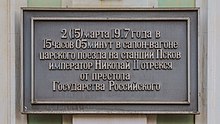
Back Адрачэнне Мікалая II Byelorussian Կայսր Նիկոլայ II-ի գահից հրաժարվելը Armenian Отречение Николая II Russian Abdication of Nicholas II SIMPLE Зречення Миколи II Ukrainian
You can help expand this article with text translated from the corresponding article in Russian. (May 2019) Click [show] for important translation instructions.
|




Emperor Nicholas II abdicated the throne of the Russian Empire on 2 March (O.S.) / 15 March (N.S.) 1917, in the midst of World War I and the February Revolution. The Emperor renounced the throne on behalf of himself and his son, Tsarevich Alexei Nikolaevich, in favor of his brother Grand Duke Michael Alexandrovich.[1] The next day the Grand Duke refused to accept the imperial authority,[1] stating that he would accept it only if that was the consensus of democratic action by the Russian Constituent Assembly, which shall define the form of government for Russia.[2] With this decision, the rule of the 300-year-old House of Romanov ended.[3] Power in Russia then passed to the Russian Provisional Government, signaling victory for the February Revolution.
- ^ a b Beckett 2007, p. 523.
- ^ Browder & Kerensky 1961, p. 116.
- ^ Smith, S.A. (2002). Russia in Revolution. Oxford University Press. pp. 102. ISBN 978-0-19-285395-0.